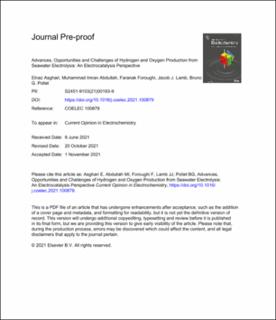| dc.contributor.author | Asghari, Elnaz | |
| dc.contributor.author | Muhammad Imran, Abdullah | |
| dc.contributor.author | Foroughi, Faranak | |
| dc.contributor.author | Lamb, Jacob Joseph | |
| dc.contributor.author | Pollet, Bruno | |
| dc.date.accessioned | 2021-11-22T15:14:40Z | |
| dc.date.available | 2021-11-22T15:14:40Z | |
| dc.date.created | 2021-11-16T10:27:27Z | |
| dc.date.issued | 2021 | |
| dc.identifier.issn | 2451-9103 | |
| dc.identifier.uri | https://hdl.handle.net/11250/2830783 | |
| dc.description.abstract | With increasing energy consumption and greenhouse gas emissions, the importance of developing renewable energy sources to replace fossil fuels has become a vital global task. Hydrogen produced via water electrolysis powered by renewable energy systems at a large scale is an essential measure to reduce greenhouse gas and particulate emissions. Electrolysers use a substantial amount of water (mainly freshwater) to produce hydrogen and oxygen at the cathode, and anode, respectively. However, seawater is preferred because it is the most abundant water resource. Although many R&D efforts on seawater electrolysis have been carried out since the 1970s, the barriers are the undesired chlorine gas evolution reaction at the anode, and corrosion induced by chloride ions. Unlike the available data for electrocatalyst materials based upon platinum group metals in pure solutions, limited data is available for electrocatalysts in seawater. Therefore, there is an urgent need to develop new electrocatalysts for seawater electrolysis. | en_US |
| dc.language.iso | eng | en_US |
| dc.publisher | Elsevier | en_US |
| dc.rights | Attribution-NonCommercial-NoDerivatives 4.0 Internasjonal | * |
| dc.rights.uri | http://creativecommons.org/licenses/by-nc-nd/4.0/deed.no | * |
| dc.title | Advances, Opportunities and Challenges of Hydrogen and Oxygen Production from Seawater Electrolysis: An Electrocatalysis Perspective | en_US |
| dc.type | Peer reviewed | en_US |
| dc.type | Journal article | en_US |
| dc.description.version | acceptedVersion | en_US |
| dc.rights.holder | This is the authors' accepted manuscript to an article published by Elsevier. Locked until 15.11.2023 due to copyright restrictions. The AAM is made available under the CC-BY-NC-ND 4.0 license http://creativecommons.org/licenses/by-nc-nd/4.0/ | en_US |
| dc.source.journal | Current Opinion in Electrochemistry | en_US |
| dc.identifier.doi | https://doi.org/10.1016/j.coelec.2021.100879 | |
| dc.identifier.cristin | 1955008 | |
| cristin.ispublished | true | |
| cristin.fulltext | postprint | |
| cristin.qualitycode | 1 | |

